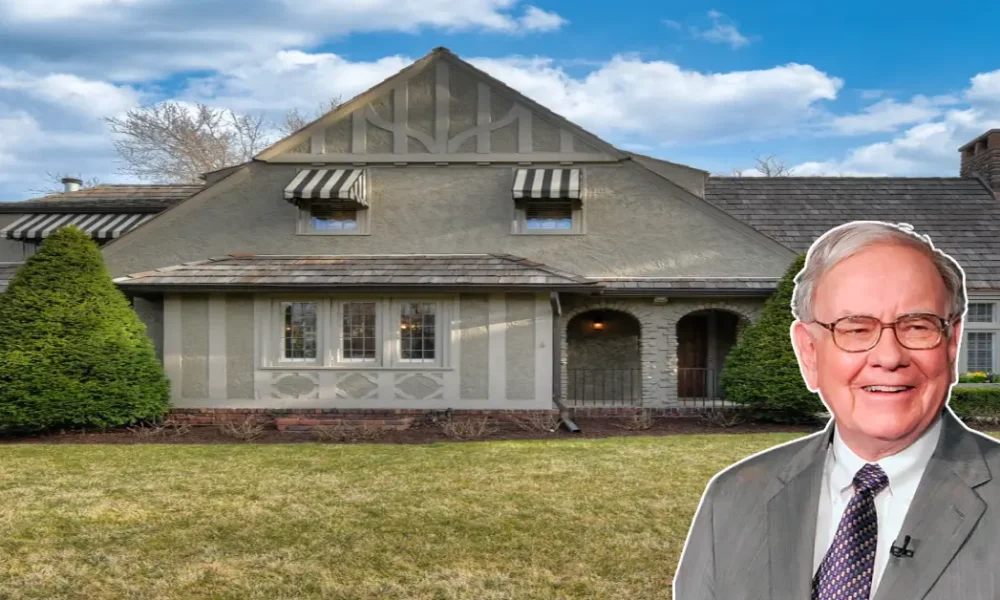Most billionaires own massive mansions with tennis courts, pools, and security gates. Warren Buffett chose differently.
The Warren Buffett house sits quietly in Omaha’s Dundee neighborhood, looking like any other family home on the block.
This story challenges everything we think we know about wealth, success, and the American dream in surprising ways.
The Basic Facts About Warren Buffett Home
Buffett bought his current home in 1958 for $31,500 when he was just 28 years old and starting his investment career.
The five-bedroom stucco house at 5505 Farnam Street spans 6,570 square feet with two and a half bathrooms, built originally in 1921.
Today, this same property sits worth approximately $1.4 million, representing a 45-fold increase from Buffett’s original purchase price over nearly seven decades of ownership.
The neighborhood itself reflects classic American suburban living, with tree-lined streets and well-maintained homes that create a sense of community rather than isolation.
That $31,500 purchase price equals roughly $329,505 in today’s dollars, making it a reasonable middle-class home purchase for its time period.
The property sits on a corner lot in the upscale Dundee area, providing both privacy and accessibility for the world’s most famous investor.
Despite his net worth of $160.3 billion as of 2025, Buffett shows no interest in upgrading to something more elaborate or expensive.
Why Buffett Chose This Omaha Home in 1958
Smart location played a huge role in Buffett’s decision, as the house sits just five minutes from Berkshire Hathaway’s corporate headquarters downtown.
The Dundee neighborhood offered stability and established community roots that aligned with Buffett’s long-term thinking approach to both life and investing.
Unlike flashy purchases that lose value quickly, Buffett saw his home as a practical investment that would serve his family’s needs reliably.
The timing of his 1958 purchase occurred during a period of general economic growth and stability, while property values remained relatively modest.
This strategic timing advantage contributed to the exceptional returns he achieved, though his decision to hold through multiple market cycles demonstrates patience.
Young Buffett already demonstrated the value-driven mindset that would define his investment philosophy throughout his career and personal life choices.
Before purchasing, he and his late wife Susan rented a home in the same neighborhood for $175 monthly, giving them firsthand knowledge.
What Makes the Warren Buffett House Special Today
The exterior features traditional design elements including a barn-shaped roof, prominent chimney, and a blend of brick and stucco that ages gracefully.
Inside, the home emphasizes practical luxury over flashy decoration, with vaulted ceilings, exposed beams, and light grey walls creating an open, comfortable atmosphere.
The kitchen follows a U-shaped layout with granite counters and white appliances, designed for actual cooking and family interaction rather than impressive displays.
One room holds special historical significance: the sunroom where Buffett established his first investment partnership, Buffett Associates, in 1956.
This small space now bears Buffett’s handwritten inscription marking it as the birthplace of his business empire that would eventually become Berkshire Hathaway.
The dining area embraces minimalism with neutral tones, rustic wooden furniture, and strategically placed lighting that creates intimate family meal atmospheres.
Well-manicured landscaping and lush greenery surrounding the house create tranquility that contrasts sharply with typical sprawling billionaire estates and their imposing designs.
The symmetrical window arrangement and understated brick elegance reflect Buffett’s preference for balanced, practical design over expensive architectural statements or flashy materials.
The Investment Returns on This Property
The Warren Buffett house generated approximately 4,300% returns over his 67-year ownership period, significantly outpacing median U.S. home price increases during the same timeframe.
Buffett consistently ranks this real estate purchase as his third-best investment ever, trailing only his wedding rings in personal satisfaction and value creation.
When compared to broader market performance, his home appreciation demonstrates the power of buying quality assets in desirable locations and holding them.
The median U.S. home price rose from $17,800 in 1963 to $416,900 in early 2025, representing roughly a 23-fold increase.
This comparison shows Buffett’s property nearly doubled the national average appreciation rate, proving location and timing matter tremendously in real estate.
The investment success demonstrates buying quality assets in desirable locations and holding them for extended periods, principles aligning with his philosophy.
Beyond financial returns, the property provided intangible benefits including stability, community connection, and emotional attachment throughout his remarkable career journey.
Smart Lessons for Regular Home Buyers
Property taxes on the Warren Buffett house remain remarkably low compared to other billionaire homes, demonstrating how smart location choices reduce ongoing costs.
His approach shows that buying within your means and focusing on functionality rather than status often generates better long-term financial results.
The home’s 6,570 square feet provides ample space without the massive maintenance costs, security expenses, and staff requirements of typical billionaire estates.
Buffett’s satisfaction with his modest home proves that happiness and comfort don’t require dramatic spending on expensive materials or elaborate architectural features.
Lower maintenance and operational costs extend beyond property taxes to include utilities, security, staffing, and general upkeep expenses for practical living.
Industry professionals emphasize the value of buying within one’s means and focusing on functionality rather than status when making housing decisions.
The approach demonstrates that successful real estate investment doesn’t require purchasing the most expensive available property in any given market area.
His decision to hold the property through multiple market cycles demonstrates the value of long-term thinking over tactical market timing strategies.
Current median home prices in Omaha around $275,000 represent nearly nine times Buffett’s original purchase price, even after accounting for inflation.
Current Market Perspective and Future Plans
During Berkshire Hathaway’s 2025 shareholder meeting, Buffett announced his retirement but expressed no plans to change his living arrangements or sell company shares.
When asked about real estate versus stock investments, Buffett emphasized his preference for equities, citing greater opportunities in the security market than real estate.
His continued satisfaction with his long-held property demonstrates that thoughtful real estate decisions can provide both financial returns and personal fulfillment.
The 94-year-old investor shocked attendees by announcing his intention to retire by year’s end, recommending vice chairman Greg Abel as replacement.
Despite stepping down as CEO, Buffett indicated he has no intention of selling one share of Berkshire Hathaway stock ownership.
This retirement announcement raises questions about potential changes to his real estate holdings, though significant changes appear unlikely given emotional attachment.
His assessment reflects analysis of current market conditions and opportunity costs rather than fundamental rejection of real estate as investment vehicle.
Since 1988, the S&P 500 significantly outperformed residential real estate, with stocks returning 2,218% compared to real estate’s 374% appreciation rate.
Property Comparison with Other Billionaire Homes
Among billionaire properties owned by Bill Gates, Mark Zuckerberg, Larry Ellison, and Jeff Bezos, Buffett’s generates the lowest property tax burden by far.
While Gates’ home commands $1.03 million annually in property taxes, Buffett’s modest property incurs just a fraction of this cost.
This dramatic difference illustrates how housing decisions can significantly impact ongoing wealth accumulation and preservation over decades of ownership.
The efficiency aligns with Buffett’s broader philosophy of minimizing unnecessary expenses to maximize resources available for wealth-generating investment activities.
Many billionaires use real estate as social signaling and status demonstration, while Buffett consistently emphasizes function over form in decisions.
His famous statement that possessions possess you at a point captures his belief that excessive material accumulation becomes burdensome.
This philosophy extends to broader lifestyle choices, including preferences for McDonald’s breakfast and simple clothing, demonstrating consistency across consumption.
Historical Significance and Business Legacy
Beyond its role as family residence, the Warren Buffett house holds significant historical importance in the development of his business empire.
The property contains the sunroom where Buffett established one of his first investment partnerships, creating the foundation for massive future success.
This historical significance adds substantial intangible value that extends far beyond market price appreciation or standard real estate metrics.
The room represents modest beginnings of one of history’s most successful investment careers, proving significant achievements need not require elaborate facilities.
Like other iconic American homes that shaped history, including the Justin Timberlake House which showcased how personal residences reflect their owners’ values and principles, Buffett’s home tells a story beyond its walls.
In 2019, Buffett returned to visit this space with two children, Howard and Susan, reflecting on memories and experiences shaping his career.
This sentimental attachment illustrates how real estate provides value through emotional connection and historical significance that transcends purely financial considerations completely.
What This Means for You
The Warren Buffett house story teaches us that successful real estate investment doesn’t require purchasing the most expensive available property in your market.
Instead, focus on finding homes that meet your actual needs while providing good value for the purchase price, just like Buffett did.
His example suggests that disciplined decision-making based on fundamental value and long-term thinking often beats emotional or status-driven purchases every single time.
The key takeaway? True wealth lies not in what you own, but in making wise decisions that support both financial success and personal happiness.
Contemporary market conditions present different challenges for homebuyers, with property values significantly higher relative to incomes than when Buffett made his purchase.
The lesson for modern investors involves focusing on long-term value creation rather than short-term market fluctuations or trendy neighborhood selections.
Buffett’s housing philosophy reinforces his broader lesson that true wealth lies in wisdom to make decisions supporting both financial success and fulfillment.




No Comment! Be the first one.